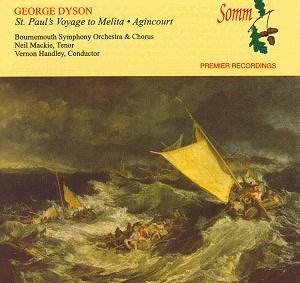Dyson,
shattered by his service in the trenches, returned to the Royal
College of Music a man shaken, transformed. Confidence returned
slowly. His Three Rhapsodies for string quartet (on Hyperion)
were published by the Carnegie UK Trust along with such ikons
of the British musical renaissance as Finzi's Introit,
Bantock's Hebridean, and Armstrong Gibbs' Bluebird.
Soon he established himself as a writer of grand choral pieces.
In 1928 there was In Honour of the City (before the splendid
Walton piece). In 1930 came The Canterbury Pilgrims (Chandos).
The Three Choirs and other choral committees began to commission
from him and there came forth St Paul's Voyage to Melita (performed
at the Three Choirs 1933, 1934, 1937 and 1952), The Blacksmiths
(Leeds, 1934 - recorded with other attractive Dysoniana on
Somm Céleste SOMMCD014), Nebuchadnezzar (Worcester,
1935) and then his magnum opus, Quo Vadis (1949, rec. Chandos
CHAN 10061(2). He had the good fortune (and misfortune) to live
on into the 1960s when his music seemed fusty by comparison with
the experiments welcomed by the young bloods at the BBC and elsewhere.
St
Paul's Voyage sets sections of Chapter 27 of Acts: the journey
from Rome to shipwreck on Malta. Dyson's writing is curvaceous,
mellifluous, without jagged edges and with a certain summer heaviness
about it. Parallels include the more contented choral writing
in Walton's Belshazzar's Feast and Howard Hanson's insufficiently
celebrated Lament for Beowulf. The choir is well coached.
Their words can for the most part be heard rather than lost in
a generalised mist of sibilants. Dyson is superb at the ostinato
tread, with the music for the words Nevertheless the Centurion
(5.20), similar to the equally gritty tread in Quo Vadis for
Part III O whither shall my troubled muse incline. Extremely
effective stuff. If Dvořák's New World is recalled
in the opening you can also catch a glimpse of the orchestral
Scriabin and Miaskovsky at 12.00 and 23.12. The work represents
an entertainingly varied narrative though the world of the spirit
is not so well caught as Vaughan Williams would have achieved.
There are some restless sections such as the determined little
interlude at 16.43 which sounds like Sainton's The Island.
The tolling figure that dominates the last five minutes might
perhaps have been recalled by William Alwyn in the 1970s when
writing his Fifth Symphony Hydriotaphia.
While
spirituality is not the forte of St Paul's Voyage this
is certainly to the fore in the Nocturne from Quo Vadis.
It is a contentedly balmy and lyrical interlude with the viola
as the quiet comforter and the organ chiming a 'tail' to the main
melody In the hour of my distress. Sadly the violist is
not identified. Can anyone tell me who it is? It is worth noting
that the very same Neil Mackie who made this recording in the
1980s is also the tenor in the St Paul work the sessions
for which took place in 2002.
Agincourt,
a very late work, has at the start and at 3.10, a Waltonian ebullience
like the cracking Te Deum by the Oldham composer. Other
influences include Vaughan Williams from Dona Nobis Pacem.
Some of the more roundedly mellow moments suggest that Dyson knew
his Finzi as well (7.07 suggesting Intimations of Immortality).
This
disc reissues the Quo Vadis extract from a couple of Dyson
LPs produced by Unicorn during the 1960s. However the commanding
presence of this SOMM release on the shelves is established by
the world premiere recordings of St Paul's Voyage and of
Agincourt, the latter written for the 1956 Petersfield
Music Festival. The words are from Shakespeare's Henry V and
the subject will be musically familiar from the Walton film score
(still best heard on EMI Classics CDM 5 65007 2) and from
the Patrick Doyle soundtrack from the Ken Branagh film.
The
notes are by Lewis Foreman who does his usual job which is to
say - full, rejecting routine information, making new and intriguing
connections and challenging assumptions.
This
recording was made with the financial assistance of the Dyson
Trust whose dogged determination has seen most of Dyson's works
(including the Symphony and Violin Concerto on Chandos) added
to the catalogue. Remaining are the cello and orchestra triptych
(intriguingly recorded in cello and piano version by Continuum
and one orchestral movement of which was included in the Julian
Lloyd Webber English collection on Philips) and the most ambitious
other hopes lie in the direction of Nebuchadnezzar.
Vintage
splendour from Dyson the magnificent.
Rob
Barnett
